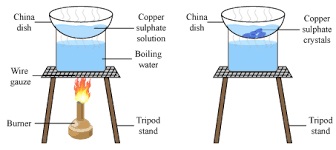Q. Give a brief description of the principles of Crystallisation taking an example.
Ans:
Crystallisation: Crystallisation is one of the most commonly used techniques for the purification of solid organic compounds.
Principle: It is based on the difference in the solubilites of the compound and the impurities in a given solvent. The impure compound gets dissolved in the solvent in which it is sparingly soluble at room temperature, but appreciably soluble at higher temperature. The solution is concentrated to obtain a nearly saturated solution. On cooling the solution, the pure compound crystallises out and is removed by filtration. For example, pure copper sulphate is obtained by recrystallising crude copper sulphate. Approximately 2 – 4 g of crude copper sulphate is dissolved in about 20 mL of water containing few drops of sulphuric acid. The solution is heated (if necessary) to ensure complete dissolution. The solution is then left undisturbed until some crystals start to separate out. The crystals are then filtered and dried.
